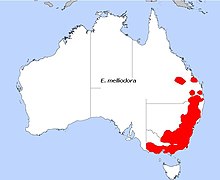Eucalyptus melliodora
| Yellow Box | |
|---|---|

| |
| Eucalyptus melliodora, flowers & leaves | |
| Scientific classification | |
| Kingdom: | |
| (unranked): | |
| (unranked): | |
| (unranked): | |
| Order: | |
| Family: | |
| Genus: | |
| Species: | E. melliodora
|
| Binomial name | |
| Eucalyptus melliodora | |

| |
| E. melliodora, field distribution | |
Eucalyptus melliodora, commonly known as Yellow Box, is a medium sized to occasionally tall eucalypt. The bark is variable ranging from smooth with an irregular, short stocking, to covering most of the trunk, fibrous, dense or loosely held, grey, yellow or red-brown, occasionally very coarse, thick, dark brown to black; shedding from the upper limbs to leave a smooth, white or yellowish surface.
Leaves are stalked (with petiole), narrow-lanceolate to lanceolate, to 14 x 1.8 cm, concolorous, dull, light green or slate grey. The intermarginal vein (obvious on most eucalypt leaves as the leaf vein that lays close to the leaf margin in a circumferential way) is markedly distant from the leaf margin in this species. This occurs in both adult and juvenile leaves.[1]
The tree is widely distributed on the eastern plains and tablelands from western Victoria, New South Wales to south-central Queensland.
E. melliodora is considered to be the best native tree for honey production, the honey produced has a delightful golden colour and an excellent taste. The timber is pale brown, dense and heavy (about 1100 kg/m3), resistant to decay and has been used for sleepers, posts, poles and bridges. It is not known as a furniture timber.
Gallery
-
E. melliodora in Wagga Wagga, New South Wales
-
Leaf
-
Leaves
-
Gumnuts and blossoms
-
trunk detail
-
Flower cluster
Pop culture references
In the 1985 Australian film Bliss, the Yellow Box is the tree planted as "the letter that took eight years to deliver".
References
- Bootle KR. (1983). Wood in Australia. Types, properties and uses. McGraw-Hill Book Company, Sydney. ISBN 0074510479
- ^ Brooker & Kleinig, Eucalyptus, An illustrated guide to identification, Reed Books, Melbourne, 1996





